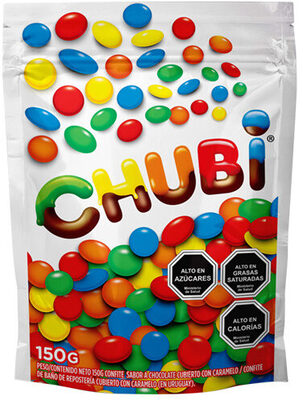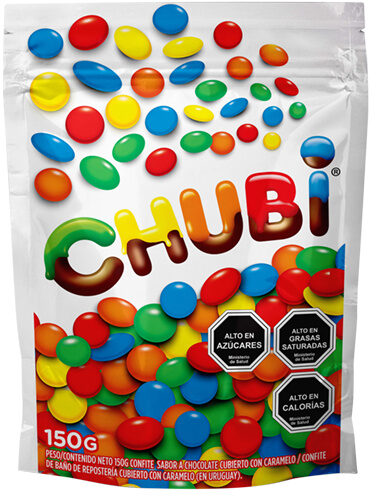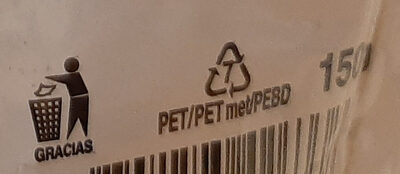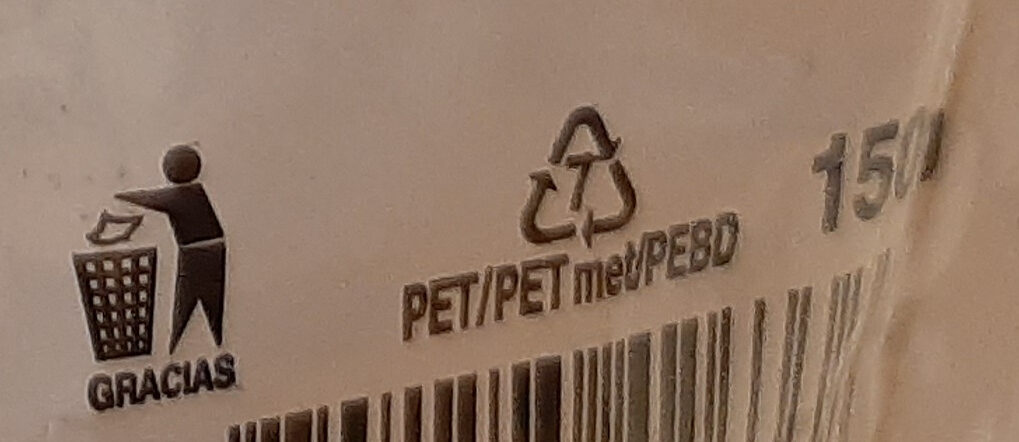Help us make food transparency the norm!
As a non-profit organization, we depend on your donations to continue informing consumers around the world about what they eat.
The food revolution starts with you!
Chubi - Arcor - 150 g
Chubi - Arcor - 150 g
Barra-kodea: 7802225426336 (EAN / EAN-13)
Izen arrunta: confite sabor a chocolate cubierto con caramelo. confite de baño de repostería cubierto con caramelo.
Kopurua: 150 g
Ontziratzea: en:Plastic, en:Bag, en:other-plastics
Kategoriak: en:Snacks, en:Sweet snacks, en:Cocoa and its products, en:Confectioneries, en:Chocolate candies, en:Chocolates, en:Candies, en:Milk chocolates, en:Sugar coated chocolate confectioneries
Etiketak, ziurtagiriak, sariak:
Halal, fr:A Votre Service, es:Alto en azúcares, es:Alto en calorías, es:Alto en grasas saturadas

Origin of ingredients: Txile
Manufacturing or processing places: Santiago, Chile
Traceability code: 08772/2014, 080503190006, 040305190232, 040503190009, RFC UME941006L77, IM SRA 1409/
Link to the product page on the official site of the producer: https://www.arcor.cl/
Dendak: Tottus
Saltzen diren herrialdeak: Bolivia, Txile, Costa Rica, Ekuador, Mexiko, Paraguai, Peru, Espainia, Uruguai, Venezuela
Matching with your preferences
Health
Osagaiak
-
31 ingredients
Gaztelania: AZÚCAR, MEZCLA DE GRASA VEGETAL (PALMA, SHEA, PALMISTE), CACAO EN POLVO, LECHE DESCREMADA EN POLVO, SUERO DE LECHE, EMULSIONANTE (LECITINA DE SOYA), COLORANTES (DIÓXIDO DE TITANIO (E171), ROJO ALLURA AC (E129), TARTRAZINA (E102), AMARILLO OCASO (E110), INDIGOTINA (E132), AZUL BRILLANTE FCF (E133)), ESPESANTE (GOMA ARÁBIGA), SABORIZANTE IDÉNTICO A NATURAL, JARABE DE GLUCOSA, GLASEANTE (GOMA LACA, CERA CARNAUBA), MALTODEXTRINA.Alergenoak: en:Gluten, en:Milk, en:Soybeans, es:tartrazinaAztarnak: en:Eggs, en:Gluten, en:Nuts, en:Peanuts
Food processing
-
Ultra processed foods
Elements that indicate the product is in the 4 - Ultra prozesatutako elikagaiak eta edariak group:
- Gehigarria: E102
- Gehigarria: E110
- Gehigarria: E129
- Gehigarria: E132
- Gehigarria: E133
- Gehigarria: E171
- Gehigarria: E322
- Gehigarria: E414
- Gehigarria: E903
- Gehigarria: E904
- Osagaia: Colour
- Osagaia: Emulsifier
- Osagaia: Glukosa
- Osagaia: Almibar
- Osagaia: Maltodextrin
- Osagaia: Thickener
- Osagaia: Esne-gazur
Food products are classified into 4 groups according to their degree of processing:
- Prozesatu gabeko edo ahalik eta gutxien prozesatutako elikagaiak
- Sukaldaritzako osagaiak prozesatu
- Prozesatutako jakiak
- Ultra processed foods
The determination of the group is based on the category of the product and on the ingredients it contains.
Gehigarriak
-
E102
Tartrazine: Tartrazine is a synthetic lemon yellow azo dye primarily used as a food coloring. It is also known as E number E102, C.I. 19140, FD&C Yellow 5, Acid Yellow 23, Food Yellow 4, and trisodium 1--4-sulfonatophenyl--4--4-sulfonatophenylazo--5-pyrazolone-3-carboxylate-.Tartrazine is a commonly used color all over the world, mainly for yellow, and can also be used with Brilliant Blue FCF -FD&C Blue 1, E133- or Green S -E142- to produce various green shades.Source: Wikipedia (Ingeles)
-
E110
Sunset Yellow FCF: Sunset Yellow FCF -also known as Orange Yellow S, or C.I. 15985- is a petroleum-derived orange azo dye with a pH dependent maximum absorption at about 480 nm at pH 1 and 443 nm at pH 13 with a shoulder at 500 nm. When added to foods sold in the US it is known as FD&C Yellow 6; when sold in Europe, it is denoted by E Number E110.Source: Wikipedia (Ingeles)
-
E129
Allura Red AC: Allura Red AC is a red azo dye that goes by several names, including FD&C Red 40. It is used as a food dye and has the E number E129. It is usually supplied as its red sodium salt, but can also be used as the calcium and potassium salts. These salts are soluble in water. In solution, its maximum absorbance lies at about 504 nm.Source: Wikipedia (Ingeles)
-
E132
Indigo carmine: Indigo carmine, or 5‚5′-indigodisulfonic acid sodium salt, is an organic salt derived from indigo by sulfonation, which renders the compound soluble in water. It is approved for use as a food colorant in the U.S and E.U., It has the E number E132. It is also a pH indicator.Source: Wikipedia (Ingeles)
-
E133
Brilliant Blue FCF: Brilliant Blue FCF -Blue 1- is an organic compound classified as a triarylmethane dye and a blue azo dye, reflecting its chemical structure. Known under various commercial names, it is a colorant for foods and other substances. It is denoted by E number E133 and has a color index of 42090. It has the appearance of a blue powder. It is soluble in water, and the solution has a maximum absorption at about 628 nanometers.Source: Wikipedia (Ingeles)
-
E171
Titanium dioxide: Titanium dioxide, also known as titaniumIV oxide or titania, is the naturally occurring oxide of titanium, chemical formula TiO2. When used as a pigment, it is called titanium white, Pigment White 6 -PW6-, or CI 77891. Generally, it is sourced from ilmenite, rutile and anatase. It has a wide range of applications, including paint, sunscreen and food coloring. When used as a food coloring, it has E number E171. World production in 2014 exceeded 9 million metric tons. It has been estimated that titanium dioxide is used in two-thirds of all pigments, and the oxide has been valued at $13.2 billion.Source: Wikipedia (Ingeles)
-
E322
Lecithin: Lecithin -UK: , US: , from the Greek lekithos, "egg yolk"- is a generic term to designate any group of yellow-brownish fatty substances occurring in animal and plant tissues, which are amphiphilic – they attract both water and fatty substances -and so are both hydrophilic and lipophilic-, and are used for smoothing food textures, dissolving powders -emulsifying-, homogenizing liquid mixtures, and repelling sticking materials.Lecithins are mixtures of glycerophospholipids including phosphatidylcholine, phosphatidylethanolamine, phosphatidylinositol, phosphatidylserine, and phosphatidic acid.Lecithin was first isolated in 1845 by the French chemist and pharmacist Theodore Gobley. In 1850, he named the phosphatidylcholine lécithine. Gobley originally isolated lecithin from egg yolk—λέκιθος lekithos is "egg yolk" in Ancient Greek—and established the complete chemical formula of phosphatidylcholine in 1874; in between, he had demonstrated the presence of lecithin in a variety of biological matters, including venous blood, in human lungs, bile, human brain tissue, fish eggs, fish roe, and chicken and sheep brain. Lecithin can easily be extracted chemically using solvents such as hexane, ethanol, acetone, petroleum ether, benzene, etc., or extraction can be done mechanically. It is usually available from sources such as soybeans, eggs, milk, marine sources, rapeseed, cottonseed, and sunflower. It has low solubility in water, but is an excellent emulsifier. In aqueous solution, its phospholipids can form either liposomes, bilayer sheets, micelles, or lamellar structures, depending on hydration and temperature. This results in a type of surfactant that usually is classified as amphipathic. Lecithin is sold as a food additive and dietary supplement. In cooking, it is sometimes used as an emulsifier and to prevent sticking, for example in nonstick cooking spray.Source: Wikipedia (Ingeles)
-
E322i - Lezitina
Lecithin: Lecithin -UK: , US: , from the Greek lekithos, "egg yolk"- is a generic term to designate any group of yellow-brownish fatty substances occurring in animal and plant tissues, which are amphiphilic – they attract both water and fatty substances -and so are both hydrophilic and lipophilic-, and are used for smoothing food textures, dissolving powders -emulsifying-, homogenizing liquid mixtures, and repelling sticking materials.Lecithins are mixtures of glycerophospholipids including phosphatidylcholine, phosphatidylethanolamine, phosphatidylinositol, phosphatidylserine, and phosphatidic acid.Lecithin was first isolated in 1845 by the French chemist and pharmacist Theodore Gobley. In 1850, he named the phosphatidylcholine lécithine. Gobley originally isolated lecithin from egg yolk—λέκιθος lekithos is "egg yolk" in Ancient Greek—and established the complete chemical formula of phosphatidylcholine in 1874; in between, he had demonstrated the presence of lecithin in a variety of biological matters, including venous blood, in human lungs, bile, human brain tissue, fish eggs, fish roe, and chicken and sheep brain. Lecithin can easily be extracted chemically using solvents such as hexane, ethanol, acetone, petroleum ether, benzene, etc., or extraction can be done mechanically. It is usually available from sources such as soybeans, eggs, milk, marine sources, rapeseed, cottonseed, and sunflower. It has low solubility in water, but is an excellent emulsifier. In aqueous solution, its phospholipids can form either liposomes, bilayer sheets, micelles, or lamellar structures, depending on hydration and temperature. This results in a type of surfactant that usually is classified as amphipathic. Lecithin is sold as a food additive and dietary supplement. In cooking, it is sometimes used as an emulsifier and to prevent sticking, for example in nonstick cooking spray.Source: Wikipedia (Ingeles)
-
E414
Gum arabic: Gum arabic, also known as acacia gum, arabic gum, gum acacia, acacia, Senegal gum and Indian gum, and by other names, is a natural gum consisting of the hardened sap of various species of the acacia tree. Originally, gum arabic was collected from Acacia nilotica which was called the "gum arabic tree"; in the present day, gum arabic is collected from acacia species, predominantly Acacia senegal and Vachellia -Acacia- seyal; the term "gum arabic" does not indicate a particular botanical source. In a few cases so‐called "gum arabic" may not even have been collected from Acacia species, but may originate from Combretum, Albizia or some other genus. Producers harvest the gum commercially from wild trees, mostly in Sudan -80%- and throughout the Sahel, from Senegal to Somalia—though it is historically cultivated in Arabia and West Asia. Gum arabic is a complex mixture of glycoproteins and polysaccharides. It is the original source of the sugars arabinose and ribose, both of which were first discovered and isolated from it, and are named after it. Gum arabic is soluble in water. It is edible, and used primarily in the food industry as a stabilizer, with EU E number E414. Gum arabic is a key ingredient in traditional lithography and is used in printing, paint production, glue, cosmetics and various industrial applications, including viscosity control in inks and in textile industries, though less expensive materials compete with it for many of these roles. While gum arabic is now produced throughout the African Sahel, it is still harvested and used in the Middle East.Source: Wikipedia (Ingeles)
-
E903
Carnauba wax: Carnauba -; Portuguese: carnaúba [kaʁnɐˈubɐ]-, also called Brazil wax and palm wax, is a wax of the leaves of the palm Copernicia prunifera -Synonym: Copernicia cerifera-, a plant native to and grown only in the northeastern Brazilian states of Piauí, Ceará, Maranhão, Bahia, and Rio Grande do Norte. It is known as "queen of waxes" and in its pure state, usually comes in the form of hard yellow-brown flakes. It is obtained from the leaves of the carnauba palm by collecting and drying them, beating them to loosen the wax, then refining and bleaching the wax.Source: Wikipedia (Ingeles)
-
E904
Shellac: Shellac is a resin secreted by the female lac bug, on trees in the forests of India and Thailand. It is processed and sold as dry flakes -pictured- and dissolved in alcohol to make liquid shellac, which is used as a brush-on colorant, food glaze and wood finish. Shellac functions as a tough natural primer, sanding sealant, tannin-blocker, odour-blocker, stain, and high-gloss varnish. Shellac was once used in electrical applications as it possesses good insulation qualities and it seals out moisture. Phonograph and 78 rpm gramophone records were made of it until they were replaced by vinyl long-playing records from the 1950s onwards. From the time it replaced oil and wax finishes in the 19th century, shellac was one of the dominant wood finishes in the western world until it was largely replaced by nitrocellulose lacquer in the 1920s and 1930s.Source: Wikipedia (Ingeles)
Ingredients analysis
-
en:Palm oil
Ingredients that contain palm oil: en:Palm, Palmiste olio
-
en:Non-vegan
Non-vegan ingredients: en:Skimmed milk powder, Esne-gazur, E904Some ingredients could not be recognized.
We need your help!
You can help us recognize more ingredients and better analyze the list of ingredients for this product and others:
- Edit this product page to correct spelling mistakes in the ingredients list, and/or to remove ingredients in other languages and sentences that are not related to the ingredients.
- Add new entries, synonyms or translations to our multilingual lists of ingredients, ingredient processing methods, and labels.
If you would like to help, join the #ingredients channel on our Slack discussion space and/or learn about ingredients analysis on our wiki. Thank you!
-
en:Non-vegetarian
Non-vegetarian ingredients: E904Some ingredients could not be recognized.
We need your help!
You can help us recognize more ingredients and better analyze the list of ingredients for this product and others:
- Edit this product page to correct spelling mistakes in the ingredients list, and/or to remove ingredients in other languages and sentences that are not related to the ingredients.
- Add new entries, synonyms or translations to our multilingual lists of ingredients, ingredient processing methods, and labels.
If you would like to help, join the #ingredients channel on our Slack discussion space and/or learn about ingredients analysis on our wiki. Thank you!
-
Details of the analysis of the ingredients
We need your help!
Some ingredients could not be recognized.
We need your help!
You can help us recognize more ingredients and better analyze the list of ingredients for this product and others:
- Edit this product page to correct spelling mistakes in the ingredients list, and/or to remove ingredients in other languages and sentences that are not related to the ingredients.
- Add new entries, synonyms or translations to our multilingual lists of ingredients, ingredient processing methods, and labels.
If you would like to help, join the #ingredients channel on our Slack discussion space and/or learn about ingredients analysis on our wiki. Thank you!
es: AZÚCAR, GRASA VEGETAL (PALMA, SHEA, PALMISTE), CACAO EN POLVO, LECHE DESCREMADA EN POLVO, SUERO DE LECHE, EMULSIONANTE (LECITINA DE SOYA), COLORANTES (DIÓXIDO DE TITANIO (e171), ROJO ALLURA AC (e129), TARTRAZINA (e102), AMARILLO OCASO (e110), INDIGOTINA (e132), AZUL BRILLANTE FCF (e133)), ESPESANTE (GOMA ARÁBIGA), SABORIZANTE IDÉNTICO A NATURAL, JARABE DE GLUCOSA, GLASEANTE (GOMA LACA, CERA CARNAUBA), MALTODEXTRINA- AZÚCAR -> en:sugar - vegan: yes - vegetarian: yes - ciqual_proxy_food_code: 31016 - percent_min: 8.33333333333333 - percent_max: 100
- GRASA VEGETAL -> en:vegetable-fat - vegan: yes - vegetarian: yes - from_palm_oil: maybe - percent_min: 0 - percent_max: 50
- PALMA -> en:palm - vegan: yes - vegetarian: yes - from_palm_oil: yes - ciqual_food_code: 16129 - percent_min: 0 - percent_max: 50
- SHEA -> en:shea-butter - vegan: yes - vegetarian: yes - from_palm_oil: no - percent_min: 0 - percent_max: 25
- PALMISTE -> en:palm-kernel-oil - vegan: yes - vegetarian: yes - from_palm_oil: yes - percent_min: 0 - percent_max: 16.6666666666667
- CACAO EN POLVO -> en:cocoa-powder - vegan: yes - vegetarian: yes - ciqual_food_code: 18100 - percent_min: 0 - percent_max: 33.3333333333333
- LECHE DESCREMADA EN POLVO -> en:skimmed-milk-powder - vegan: no - vegetarian: yes - ciqual_food_code: 19054 - percent_min: 0 - percent_max: 25
- SUERO DE LECHE -> en:whey - vegan: no - vegetarian: maybe - percent_min: 0 - percent_max: 20
- EMULSIONANTE -> en:emulsifier - percent_min: 0 - percent_max: 16.6666666666667
- LECITINA DE SOYA -> en:soya-lecithin - vegan: yes - vegetarian: yes - ciqual_food_code: 42200 - percent_min: 0 - percent_max: 16.6666666666667
- COLORANTES -> en:colour - percent_min: 0 - percent_max: 14.2857142857143
- DIÓXIDO DE TITANIO -> en:e171 - vegan: yes - vegetarian: yes - percent_min: 0 - percent_max: 14.2857142857143
- e171 -> en:e171 - vegan: yes - vegetarian: yes - percent_min: 0 - percent_max: 14.2857142857143
- ROJO ALLURA AC -> en:e129 - vegan: yes - vegetarian: yes - percent_min: 0 - percent_max: 7.14285714285714
- e129 -> en:e129 - vegan: yes - vegetarian: yes - percent_min: 0 - percent_max: 7.14285714285714
- TARTRAZINA -> en:e102 - vegan: yes - vegetarian: yes - percent_min: 0 - percent_max: 4.76190476190476
- e102 -> en:e102 - vegan: yes - vegetarian: yes - percent_min: 0 - percent_max: 4.76190476190476
- AMARILLO OCASO -> en:e110 - vegan: yes - vegetarian: yes - percent_min: 0 - percent_max: 3.57142857142857
- e110 -> en:e110 - vegan: yes - vegetarian: yes - percent_min: 0 - percent_max: 3.57142857142857
- INDIGOTINA -> en:e132 - vegan: yes - vegetarian: yes - percent_min: 0 - percent_max: 2.85714285714286
- e132 -> en:e132 - vegan: yes - vegetarian: yes - percent_min: 0 - percent_max: 2.85714285714286
- AZUL BRILLANTE FCF -> en:e133 - vegan: yes - vegetarian: yes - percent_min: 0 - percent_max: 2.38095238095238
- e133 -> en:e133 - vegan: yes - vegetarian: yes - percent_min: 0 - percent_max: 2.38095238095238
- DIÓXIDO DE TITANIO -> en:e171 - vegan: yes - vegetarian: yes - percent_min: 0 - percent_max: 14.2857142857143
- ESPESANTE -> en:thickener - percent_min: 0 - percent_max: 12.5
- GOMA ARÁBIGA -> en:e414 - vegan: yes - vegetarian: yes - percent_min: 0 - percent_max: 12.5
- SABORIZANTE IDÉNTICO A NATURAL -> es:saborizante-identico-a-natural - percent_min: 0 - percent_max: 11.1111111111111
- JARABE DE GLUCOSA -> en:glucose-syrup - vegan: yes - vegetarian: yes - ciqual_proxy_food_code: 31016 - percent_min: 0 - percent_max: 10
- GLASEANTE -> en:glaze - percent_min: 0 - percent_max: 9.09090909090909
- GOMA LACA -> en:e904 - vegan: no - vegetarian: no - percent_min: 0 - percent_max: 9.09090909090909
- CERA CARNAUBA -> en:e903 - vegan: yes - vegetarian: yes - percent_min: 0 - percent_max: 4.54545454545455
- MALTODEXTRINA -> en:maltodextrin - vegan: yes - vegetarian: yes - percent_min: 0 - percent_max: 8.33333333333333
Elikadura
-
Bad nutritional quality
⚠ ️Warning: the amount of fruits, vegetables and nuts is not specified on the label, it was estimated from the list of ingredients: 0This product is not considered a beverage for the calculation of the Nutri-Score.
Positive points: 2
- Proteinak: 1 / 5 (balioa: 2.7, rounded value: 2.7)
- Fiber: 2 / 5 (balioa: 2.3, rounded value: 2.3)
- Fruits, vegetables, nuts, and colza/walnut/olive oils: 0 / 5 (balioa: 0, rounded value: 0)
Negative points: 26
- Energia: 6 / 10 (balioa: 2016, rounded value: 2016)
- Azukreak: 10 / 10 (balioa: 69, rounded value: 69)
- Gantz saturatua: 10 / 10 (balioa: 13, rounded value: 13)
- Sodioa: 0 / 10 (balioa: 29, rounded value: 29)
The points for proteins are not counted because the negative points are greater or equal to 11.
Nutritional score: (26 - 2)
Nutri-Score:
-
Nutrient levels
-
Koipe in high quantity (21%)
What you need to know- A high consumption of fat, especially saturated fats, can raise cholesterol, which increases the risk of heart diseases.
Recommendation: Limit the consumption of fat and saturated fat- Choose products with lower fat and saturated fat content.
-
Gantz-azido ase in high quantity (13%)
What you need to know- A high consumption of fat, especially saturated fats, can raise cholesterol, which increases the risk of heart diseases.
Recommendation: Limit the consumption of fat and saturated fat- Choose products with lower fat and saturated fat content.
-
Azukre in high quantity (69%)
What you need to know- A high consumption of sugar can cause weight gain and tooth decay. It also augments the risk of type 2 diabetes and cardio-vascular diseases.
Recommendation: Limit the consumption of sugar and sugary drinks- Sugary drinks (such as sodas, fruit beverages, and fruit juices and nectars) should be limited as much as possible (no more than 1 glass a day).
- Choose products with lower sugar content and reduce the consumption of products with added sugars.
-
Gatz arrunt in low quantity (0.0725%)
What you need to know- A high consumption of salt (or sodium) can cause raised blood pressure, which can increase the risk of heart disease and stroke.
- Many people who have high blood pressure do not know it, as there are often no symptoms.
- Most people consume too much salt (on average 9 to 12 grams per day), around twice the recommended maximum level of intake.
Recommendation: Limit the consumption of salt and salted food- Reduce the quantity of salt used when cooking, and don't salt again at the table.
- Limit the consumption of salty snacks and choose products with lower salt content.
-
-
Nutrition facts
Nutrition facts As sold
for 100 g / 100 mlAs sold
per serving (30 unidades 24 g)Compared to: en:Milk chocolates Energia 2.016 kj
(481 kcal)484 kj
(115 kcal)-% 11 Koipe 21 g 5,04 g -% 38 Gantz-azido ase 13 g 3,12 g -% 30 Gantz-azido monoasegabe 5,5 g 1,32 g -% 45 Polyunsaturated fat 1,3 g 0,312 g -% 36 Trans fat 0,1 g 0,024 g +% 50 Kolesterol 0,8 mg 0,192 mg -% 89 Carbohydrates 70 g 16,8 g +% 34 Azukre 69 g 16,6 g +% 50 Fiber 2,3 g 0,552 g -% 9 Proteina 2,7 g 0,648 g -% 64 Gatz arrunt 0,072 g 0,017 g -% 68 Fruits‚ vegetables‚ nuts and rapeseed‚ walnut and olive oils (estimate from ingredients list analysis) 0 % 0 %
Ingurumena
-
Eco-Score E - Very high environmental impact
The Eco-Score is an experimental score that summarizes the environmental impacts of food products.→ The Eco-Score was initially developped for France and it is being extended to other European countries. The Eco-Score formula is subject to change as it is regularly improved to make it more precise and better suited to each country.Life cycle analysis
-
Average impact of products of the same category: C (Score: 42/100)
Kategoria: Chocolate confectionery, sugar coated
Kategoria: Chocolate confectionery, sugar coated
- PEF environmental score: 0.70 (the lower the score, the lower the impact)
- including impact on climate change: 9.72 kg CO2 eq/kg of product
Stage Impact Agriculture
46.3 %Processing
47.8 %Ontziratzea
1.5 %Transportation
3.7 %Distribution
0.7 %Consumption
0.0 %
Bonuses and maluses
-
Origins of ingredients with a high impact
Malus: -3
Environmental policy: -3
Transportation: 0
Origin of the product and/or its ingredients % of ingredients Impact Txile 100 %Altua
-
Ingredients that threatens species
Malus: -10
Contains palm oil
Tropical forests in Asia, Africa and Latin America are destroyed to create and expand oil palm tree plantations. The deforestation contributes to climate change, and it endangers species such as the orangutan, the pigmy elephant and the Sumatran rhino.
-
Packaging with a medium impact
Malus: -10
Shape Material Recycling Impact 1 Pouch flask 07 OTHER Discard Altua
Eco-Score for this product
-
Impact for this product: E (Score: 19/100)
Produktua: Chubi - Arcor - 150 g
Life cycle analysis score: 42
Sum of bonuses and maluses: -23
Final score: 19/100
-
Carbon footprint
-
Equal to driving 5.0 km in a petrol car
972 g CO² per 100g of product
The carbon emission figure comes from ADEME's Agribalyse database, for the category: Chocolate confectionery, sugar coated (Source: ADEME Agribalyse Database)
Stage Impact Agriculture
29.1 %Processing
66.8 %Ontziratzea
1.1 %Transportation
2.8 %Distribution
0.2 %Consumption
0.0 %
Ontziratzea
-
Packaging with a medium impact
-
Packaging parts
1 x Pouch flask (07 OTHER)
-
Bilgarriaren materialak
Material % Bilgarriaren pisua Bilgarriaren pisua produktuaren 100g-ko Plastic
-
Transportation
-
Origins of ingredients
Origins of ingredients with a high impact
Origin of the product and/or its ingredients % of ingredients Impact Txile 100 %Altua
Threatened species
-
Contains palm oil
Drives deforestation and threatens species such as the orangutan
Tropical forests in Asia, Africa and Latin America are destroyed to create and expand oil palm tree plantations. The deforestation contributes to climate change, and it endangers species such as the orangutan, the pigmy elephant and the Sumatran rhino.
Report a problem
-
Incomplete or incorrect information?
Category, labels, ingredients, allergens, nutritional information, photos etc.
If the information does not match the information on the packaging, please complete or correct it. Open Food Facts is a collaborative database, and every contribution is useful for all.
Datuen iturria
Product added on by openfoodfacts-contributors
Last edit of product page on by 5m4u9.
Produktuaren orria -gatik editatua bartolomeu, diegous98, halal-app-chakib, musarana, packbot, teolemon, thaialagata.












